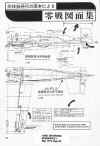
A6M1 Drawings
Evidence and Theory Presented by Jim Long
Part One
In January 1974, Koku-Fan Monthly Magazine began publishing a set of technical drawings on the Zero Fighter. The magazine called the piece "Zero Fighter Drawing Series," and the installments ran from January through December 1974. With the issue of July 1974, the publisher changed the name to "Zero Fighter Structural Drawings - Reprints of Technical Manual, J.I.N. Air Technical Arsenal."
As the series unfolded, it was clear that the drawings were authentic technical illustrations from a wartime handling manual or technical file on the Zero Fighter. Each month four pages of drawings were presented. The material was on the A6M2, primarily, but intermixed with the A6M2 drawings were a few illustrations which were obviously of the A6M1 and a few others which are suspected of being drawings of the A6M1.
The first A6M1 drawing appeared in the May 1974 issue. Page 98 of that month had diagrams of the A6M1 aerodynamic control systems, a side view and a plan view. Even without labeling, we can see that these drawings are of the A6M1 because they show a shorter fuselage with only 15 formers (fuselage stations), plus tail-cone stations g and h. This cannot be the A6M2, which added a 16th bulkhead to make the rear fuselage about 300 millimeters longer than that of the A6M1. These have to be drawings of the A6M1, of which there were only two examples. A6M No. 1 and A6M No. 2 were the only A6M1s, production serial numbers 201 and 302.
Two other factors point to these drawings being of the A6M1s. The position of the elevator on the horizontal tail is just above the fuselage reference line, as shown by the location of the elevator in the upper diagram. The stabilizer is not show but is known to have been positioned at a negative angle so as to have its leading edge at the level of the fuselage reference line. These are well-known characteristic of the two A6M1s. Also the vertical tail is broader at it base and more pointed at its tip. The broad base can be seen in the diagram, but the tip of the tail is omitted. Even so, lines can be projected to give an impression of the pointed tip. Note that the rake of the vertical tail began at fuselage station 12, contrary to that of the A6M2, where it began at station 13.
Notice, too, that the plan-view drawing shows that the flap extended to wing station 12, unlike the A6M2, which went out to station 11. This means that the A6M1s had more flap area and less aileron area than the A6M2s did.
Shigeru Nohara, the prolific Japanese aviation writer and artist, redrew these same illustrations for a Green Arrow publication called "Illustrated Zero Fighter." In that book, his drawings appear on pages 76 and 77, but are incorrectly labeled as applying to the A6M2. Apparently Nohara never noticed the differences.
Other small points of identification are the angles of travel of the elevators. The values are given in a small rectangular table at the bottom of the page, translated on the page excerpted from Koku-Fan Monthly, and untranslated and repositioned in Nohara's version on page 77 of his Green Arrow book. For the A6M1, these were
35° up and
25° down. This, by the way, was the largest movement permitted on any A6M elevator, and it may have been too much. These angles were progressively reduced in the A6M2s, beginning with A6M No. 3, which was the first A6M2 (production serial number 403). Along with a lengthened fuselage, a repositioned horizontal tail and a change in the shape of the vertical tail, the elevator travel on the first A6M2 was changed to
30° up and
24° down, eventually moving to the final figures of
27°
up and 21.5°
down by the seventh A6M ( production serial number 807, which is a plane that is famous for having been in China as 3-112 of the 12th Air Group and having been photographed with 28 victory markings on its tail).
References:
1. Koku-Fan Monthly Magazine, January through December 1974, Bunrindo Co., Ltd., Tokyo. Twelve installments of Zero drawings reportedly from the files of the Naval Air Technical Arsenal at Yokosuka.
2. Green Arrow Publishing Co., "Illustrated Zero Fighter" by Shigeru Nohara, Tokyo, 1995. This book has a lot of Nohara drawings and tracings based upon authentic technical drawings of the World-War-II era. Note: the publisher has another volume of technical drawings on the Zero listed on the Hobbylink Japan Website. I do not know much about it, except that it is supposed to have everything in the way of technical drawings of the Zero. Not many of us will have such a book, as it is listed at 12,000 Yen, close to $100.00.
3. Famous Airplanes of the World, No. 55/1995-11, "Type Zero Carrier Fighter Model 11-21," Bunrindo Co., Ltd., Tokyo, 1995. Page 25 has the photo of A6M No. 7 with the 28 kill markings.
4. Hata and Izawa, "Japanese Naval Aces and Fighter Units in World War II," English edition translated by Don C. Gorham, Naval Institute Press, 1989. Page 92 has a different photo of 3-112 of the 12th Air Group.